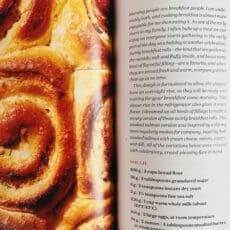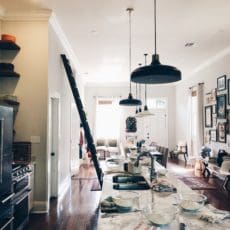
I believe in our success as bakers. Our success means a lot to me. When you step in the kitchen with a recipe, I want you to come out with a masterpiece (and like, no dishes… but that’s not realistic). We are working within certain limitations when we step into our home kitchens. We (and I’m speaking from my own experience) have a limited amount of mixing bowls, two small oven racks, not nearly enough refrigerator space, and a quickly dwindling flour jar. It’s how we work within these limitations that influence the cake that comes out of the oven.
I’d love to share a few of my tips and tricks with you. It’s all about making our lives in the kitchen easier, packing the most flavor into our baked goods, and emerging from the kitchen with something totally stellar. No fancy proofing boxes, steam-injected ovens. My kitchen is humble, but supremely delicious (so I say).
One: Let’s start where everything should start… with some good, old-fashioned mise en place. I wrote my very first (and mostly embarrassing) blog post about mise en place… that’s how strongly I feel about it. Mise en place is about having all of your ingredients prepped, softened, melted, sifted, and measured before you begin baking. It’s a great opportunity to check out your ingredients, and make sure you have everything you need before you get started. Don’t underestimate this step. There’s nothing worse than running out of buttermilk mid-recipe. A newly discovered, but very important part of my mise en place is the garbage bowl. So simple. Keep a large bowl (any bowl will do) on the counter and throw all your trashy loose ends in the bowl instead of walking back and forth to the trash can. Tracy introduced me to the garbage bowl. Game changed.
Two: Baking is a science. Sure, things need to be precise. Take yo time when baking. Take your time, and read the recipe. We’ve talked about this before. Baking 101: How To Read A Recipe
Three: Some recipes call for creaming butter and sugar. Here’s the deal, creaming butter and sugar means that you’re beating butter and sugar together (usually using an electric mixer with a paddle attachment) in order to aerate the mixture. For the best results, butter must be softened to room temperature. Cold butter will be too tough to aerate. Beat the butter and sugar for 3 to 5 minutes on medium speed. If the butter is at room temperature, after three minutes you’ll notice that the mixture is pale in color and slightly fluffy.
Four: Before the sugar gets creamed into the butter, consider whether or not your recipe has any herb or fruit zest. Rub the herb and/or fruit zest into the granulated sugar, releasing all of the essential oils. This will rub a different level of flavor into our baked goods. We’re adding major flavor to the sugar and that flavor will be distributed through our treats by way of butter. It a wonderful way to work things out.
Five: In the same way that we’re making the most of our lemon zest and herbs, we can also boost the flavor of out spices! Most recipes want us to stir our ground spices into the flour and leavening mixture. Nah…. if we beat the spices into the butter and sugar mixture, the flavors will be dispersed with the butter. Bonus: fat is great for transferring flavor.
Six: It’s really helpful to know a few baking equivalents.
3 teaspoons = 1 tablespoon
4 tablespoons = 1/4 cup
5 tablespoons + 1 teaspoon = 1/3 cup
2 cups = 1 pint
2 pints = 1 quart
4 quarts = 1 gallon
Seven: Have fun. Everything tastes better if you have a good time while making it. Don’t roll your eyes. That’s real! If you have any tricks you’d like to share from your kitchen, we’d love to hear them! Leave a comment below and share the wealth! xo.
Recourses I love:
The Joy of Cooking. This classic book has straightforward recipes using straightforward techniques. It’s a kitchen standard and you should totally have one. I find these books most lovely when handed down (all dog-eared and better stained) from your grandmother.
Keys To The Kitchen is a beautiful book by Aida Mollenkamp. It’s part technique encyclopedia and part recipe book. There are helpful graphics, super solid recipes, and really beautiful photography. I adore this book (and I’m sharing the Curry Chicken Soup with Roasted Peanuts recipe soon)!
Baking 101: How To Read A Recipe
Baking 101: Must We Sift This Flour?
Baking 101: Why We Use Unsalted Butter
Baking 101: The Difference Between Baking Soda and Baking Powder
Baking 101: The Difference Between Dutch Processed and Natural Cocoa Powder
Baking 101: Measuring Cups vs. Kitchen Scales






Baker 808
I found Keys to the Kitchen section of this post tremendously helpful! Thank you so much for sharing so many great tips.
L SHERRILL POWERS
P S. Place colander in sink so it can drain
Supriya Kutty
Great, thank you so much for sharing this information. I got to know so much from your post and I am very happy to come across this post of yours. Keep sharing such posts they are really very helpful.
Mattie Scott
Amazing! thanks for sharing helpful tips with us.
Ivy Baker
I am a terrible baker and I told my friends that I would bring a dessert to our Christmas Eve party. I liked that you pointed out that baking is a science, and you need to be very accurate with your measuring. It seems like ti would be best for me to just go buy something from a bakery.
Patience S. Modimoosi
Wow!thank you for sharing. I’m inspired and I believe God for a business in baking. Kindly send magazines or books you nay recommend to my mail
Aneske
Absolutely LOVE this page!!
Sophia @ Little Box Brownie
I wish that would happen!!! That would be great to come out the other end of a long day baking without any dishes.
al falah
I noticed that you included in your pic of mise en place a lovely cup of coffee. That goes very well with baking! Gotta go get me one now . . .
https://www.afu.ac.ae/en/overview/
Anna Marie
Yes, I love the garbage bowl idea. Usually that is my sink-it’s within my tossing area. Thank you, Joy.
Kim
Steps 4 and 5 are new to me. I’ll be sure to do them from now on. Your books are wonderful! I wish I had more time to bake.
Christina Collado
Great Tips! I never knew 1/3 cup could be measured with Tablespoons and teaspoons!
Jessica
I have a recipe that calls for “2 teaspoons instant espresso”. Am I to use the espresso powder or am I to make the coffee and add 2 teaspoons? I am scratching my head over this one as I’ve never used coffee in a recipe before. Please help!
joythebaker
The powder is what they are looking for
bookshoardergal
Great tips! I read all your Baking 101 posts and it’s very helpful. The articles are clear and concise. I love the way how you write. :) Anyways, I’m using garbage bowl every time I bake. Yay! Thank you again!
Rachel
This is going to soon become my go to blog. I am sharing it with other moms on http://www.affimity.com hoping it helps them as much.
Jenn
My best chocolate chip cookies are made after two glasses of wine (when I’m like, “omg we need cookies NOW!”). And I don’t mean my drunken self thinks they’re great. I mean I never get so many compliments on baked goods EVER as when I bring my drunken leftovers to work the next day.
Connie Eppstein
Can anyone explain why the topping on the coffee cake ends up on the bottom of the pan? It doesn’t happen every time but pretty disappointed when it does!
munchy
great post, didnt know that was called mis en place, small bags you put fruit in in the store can also be used but a bowl is earth friendly, didnt know about the butter and zest and spices so thank you for sharing
Laurie
I just read through all of your Baking 101 post and boy did I learn a lot!! I think I love you! ;) Thanks for all the helpful info!!
Grace Grits and Gardening
Great post and I totally agree with you. When I started reading the recipe cover-to-cover before starting and measuring out my ingredients in little bowls like the Barefoot Contessa, everything fell into place. Visiting from Grace Grits and Gardening. Happy New Year!
Emily @ Life on Food
I am trying to teach my husband about the mise en place. He just doesn’t get it.
LB @ Bullets and Biscuits
I agree 100% with the garage bowl, the best tip my mom showed me
aliborgas
Hiya, thanks this made my day… I’m all for mise en place as well!! Nothing like getting halfway through making something and realising you don’t have all the ingredients!! Hey, I also think there might be a couple of typos in your post (Recourses? = Resources) (better stained? = butter stained). Thanks for sharing you tips for better baking. ;)
aidammollenkamp
Thanks for the shout out, lovely!
Sugar Daze Bake Shop (@sugar_daze)
Grea tips and yup, the garbage bowl is key! I often make several recipes in quick succession for my shop and find a small bowl to hold all the wet utensils is another time saver. Otherwise you end up with a countertop wet from the used whisk, measuring spoons, etc. etc or making many many trips back and forth to the sink.
Helen Laurini
Thank you for sharing your tips. They are really great.
Judith
I’ve been baking since 1963 and still learned something new! Excellent post!
Franglais kitchen, Nazima
love this list! (I have also started making sure my mise en place is all correct and prepped before baking or other cooking!)
Barbara
Thanks Joy! I’m working on memorizing some of those measuring equivalents. I know it’ll speed things up, especially if I’m halving a recipe!
Jane Mostue
All these tips are super helpful! I will definitely try the “Rub the herb and/or fruit zest into the granulated sugar” one next time I bake.
Mae @ Passionatemae
great tips Joy! I like the tip with rubbing the zest/herb onto the sugar! Will definitely try it next time.
Khadijah
All of these tips are great! I didn’t know about tips 5 and 6 before, so thank you, and I will try them next time I bake!
meganmarie013
These are all such wonderful tips. I like the idea of a garbage bowl and the preparation aspect. Thanks for sharing!
jill
ok..i will admit to being a little compulsively neat…i have baked for years in an orderly fashion…i am willing to pull the trash from under the sink and keep it by the island if necessary…but it is only a step behind me anyway. and i don’t mind tossing eggshells in the sink to dispose later. but the garbage bowl is disturbing, rachel ray has used one all these years and i do not find it appealing. love the peels,herbs spices in the butter mix though…makes perfect sense.
Jason @ Plenty Of Zest
You know I’ve always just followed the advice to add spices with the other dry ingredients. I’ll have to try adding them to the butter now, great tip!
Mimi
This is so awesome. Best tips everrrr.
Chaunta
I just adore your tips, tricks and everything in-between. You’re the bees-knees!
Lauren @ Sweat The Sweet Stuff
Great tips! Especially about adding zest and spices to the butter! I will start doing this! :)
Christie @ Bake for Coffee
I started the “garbage bowl” a couple months ago…TOTAL game changer! Great post Joy! I love all of your useful tips! Thank you for continuously sharing your knowledge and experience!
Beth Somers
Awesome post, Joy! Even as a professional baker who develops recipes for home bakers, I learned something new. Never thought to through the ground spices in with the granulated sugar before. I will be trying that very, very soon! Bookmarking your blog, and coming back often. Happy holidays!
Kyra
Joy, I think you wrote this post for me lol. My dear boyfriend can attest to the fact that I am the least patient individual in all areas of life – including in the kitchen. I should really heed all of your advice. I regularly bake with cold butter, I never read recipes (all the way through) before hand, I never lay all my ingredients out….
The worst is when you are making a dessert that requires a few hours of refrigeration time and you haven’t read the recipe thoroughly enough to budget for that time :S
These Baking 101 posts are informative and make me think differently about my baking.
Thank you for your words of wisdom :)
Amanda @ Once Upon a Recipe
Such great advice. I love the idea of beating spices in with the butter and sugar! You’re a real genius!
Leslie Lockhart
Bake with children. Share your love of cooking with a child. They are loads of fun in the kitchen! All my kids are 20 something and they aren’t as scared of the kitchen, maybe the cleanup, but not the kitchen.
DessertForTwo
I love this series! It’s so important to cream the butter! I love that you know that. I mean, of course, you know that!
KB
I have my own twist on a garbage bowl – I just double-up or triple-up some old plastic grocery store bags and use those for trash. That way I can just tie it up and toss it in the garbage at the end, without even having to clean or store a bowl!
Andrea
I love these tips! Here’s one I’ve learned. I sometimes forget to take my butter out to soften it before I start baking. Since the microwave always ends up melting it instead of softening it, I’ve picked up two tips.
1. Put the butter on a plate and cut it into many small pieces. Smaller pieces will become soft faster! Usually it only takes 15-20 minutes, instead of several hours.
2. Put the butter in the electric mixer and beat it for about 30 seconds to a minute, before adding any sugar. That seems to help further soften the butter.
Jenna
Can I add a suggestion to enhance the garbage bowl? I line mine with a plastic bag and then toss when done. Eliminates the need to wash the bowl. One less thing to do!
joythebaker
you re brilliant!
Dixya @ Food, Pleasure, and Health
mise en place is a MUST which I have learned the hard way but its made my life much easier..
Lily @ Life, Love, and Cupcakes
miss en place really does make life SO much easier, but sometimes I kind of skip that step and usually regret it! I took a food prep class in college and mise en place and the garbage bowl concept were probably the two most helpful things I got out of it..it’s amazing really lol!
Katy
Great tips. I love the garbage bowl, it makes everything so much easier. I’m going to try miss en place next!
Emma Fox
Such a great post! Your blog is amazing as usual :)
http://www.foxtrotbravo.blogspot.com
Emma x
Mary Oliver
Same, its prob my fav also!
Mary | Strikeapose
Kerry
I love the garbage bowl idea. I love to clean as I go as I don’t have a ton of counter space so I love this idea. Always checking ingredients before baking is a good one too. I have run out a time or two thinking I had something and it totally kills the flow.
Sara
#5 is brilliant! So going to do that from now on! Thanks, Joy!
Jamie
Ditto that, for sure. Best.tip.ever. = )
Naomi Snider
I noticed that you included in your pic of mise en place a lovely cup of coffee. That goes very well with baking! Gotta go get me one now . . .
Caitlin
#5 – genius!
Rossi @ A Baking Girl
I will confess to being terrible at mise-en-place, and can usually be found running around the kitchen mid recipe, covered in flour and in desperate search of a substitute for an ingredient I just ran out of. You know what, may I should give this whole “preparation” thing a shot :)
Gry
I can so relate to taking your time when baking. EVERY SINGLE TIME I rush to do something, I fail. Even if I’ve made the recipe a million times before. That would be my number one point, I sometimes don’t do miss en place….
Love these Baking 101 posts – I learn so much! Thank you so much!
tanya | devine, tx
Thank you! Absolutely invaluable info! (And just in time for my baking extravaganza this weekend!) :-)
sublimedelights
Great! I am starting the Garbage bowl today while I bake gingerbread men
joythebaker
you’ll love it! happy holiday baking!
gracebeekman
Love these tips! Baking is most certainly a science. I’m always asking my engineering husband about why certain ingredients do different things while baking, and he’s always got some answer involving the periodic table or something. Love it!
Michelle @ A Healthy Mrs
Great tips, as always!
Agus
I love all the advices you give in thes “Backing 101” post. I would like you post some advices about how to deal with gluten-free recipes.
Thank you!
Sini | my blue&white kitchen
Mise en place. YES! Do it.
Kezia
Very helpful tips, Joy! The idea of a garbage bowl sounds very useful!
Laura (Tutti Dolci)
Great tips! (Now if only the dishes could wash themselves… ;))